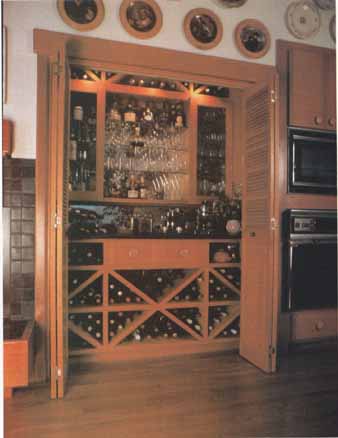Although the dining room was originally in tended as a room for dining, more often than not, it is used for this purpose only on special occasions. Instead the family eats in the kitchen, breakfast nook, or even in the living room on TV trays. Meanwhile, the dining room space either goes to waste or is not used as effectively as it could be. However, in some dining rooms there is room for a china hutch, buffet, or sideboard which can be used to store not only fine china and silver, but anything else you need to find a home for. Closed dining room storage such as buffets, which are really just cabinets with shelves and usually some drawers, can be used to hold art supplies, office supplies, out-of-season sweaters, CDs, DVDs, old videotapes, and anything else that you need stored behind closed doors. Hutches with glass doors can house books, knick knacks, and collections as well as fine glass ware and china. Space permitting, you can even put up a wall unit in the dining room that can hold glassware and liquor, making it an instant “bar.” Plants, photos, and other mementos can be displayed on the upper shelves.
Storing things other than china, silver, and glassware, in these hutches and buffets works best when the room is multifunctional. For example, if you regularly do paperwork at the table, it makes perfect sense to have your pa per supplies immediately at hand. Or, if you work on art projects here (perhaps with a drop cloth over the table), you’ll want the art supplies close at hand. On the other hand, if you’re experiencing a real storage space crunch, you may want to adapt this advice, storing things here even if they are used in another room. For instance, you could use the buffet as an instant linen cabinet if you have no linen closet.
Small apartments or condominiums that have a combined living and dining room can use bookcases to serve as a partial divider between the two spaces. If there is room you can place two bookcases back to back, with the bookcase facing the dining area used to store glassware, and the bookcase facing the living area used to store books. For extremely small studio apartments where there is virtually no space allocated for dining, a wall unit running the length of the studio can be the answer. A drop-down table, mounted on hinges, can be built into the wall unit design, so that it can be pulled into position as for meals. (It also functions as work space for writing or paying bills.) If you entertain, there are freestanding tables today that fold down to occupy only inches of space, yet can be ex tended to seat six. Or a Parsons table could double as a desk and be cleared to seat several people for dinner in a too small studio apartment.
Other storage possibilities in the dining area include a small attractive dresser or a nightstand with drawers that can be used to hold placemats and napkins along with special candles. You could install a custom wine rack in the dining room, either along a wall or as a divider between the dining and living areas, or you might use a freestanding rack that’s mounted on the wall, or placed along a short wall or in a corner.

This closet has been converted into a bar and wine storage
area.
If your dining room does double duty as a hobby center or office, how about running closed cabinetry around the room? This can be as simple as getting unfinished wood cup boards or as fancy as ordering custom-built cabinets. Low cabinetry can be topped with cushions to provide a seating area for reading or other activities, and, with the table pulled over, it serves as the seating for dining as well. And, although traditionally the table sits in the center of the dining room, if you need more functional space, experiment with placing the table against a wall to free up other wall space in the room for storage. If you need the entire table for dining (to seat four or five people every day), you might be able to place the table with the short end against the wall (losing only one seat), then lift up one of the end leaves to compensate. By pushing even one end against the wall you can often buy lots of extra space in the dining room and unclog traffic as well.
Remember that just because it is the “dining” room doesn’t mean that you have to stick to tradition and use it only for that purpose. The dining area represents space, and where there’s space, there’s storage potential to serve just about any possible need.
This cabinetry can accommodate any number of things. Here, one side has been turned into a bar, and the other side has been utilized as an entertainment center. China, silver, and table linens could also be easily stored, or if you use your dining room table for paperwork, this cabinet will do a nice job storing office supplies.
This cabinet is integrated into the design of the kitchen with the built-in appliances and fridge, strategically positioned. The island range and breakfast bar invite conversation, and function to meet in the “heart” of the home.